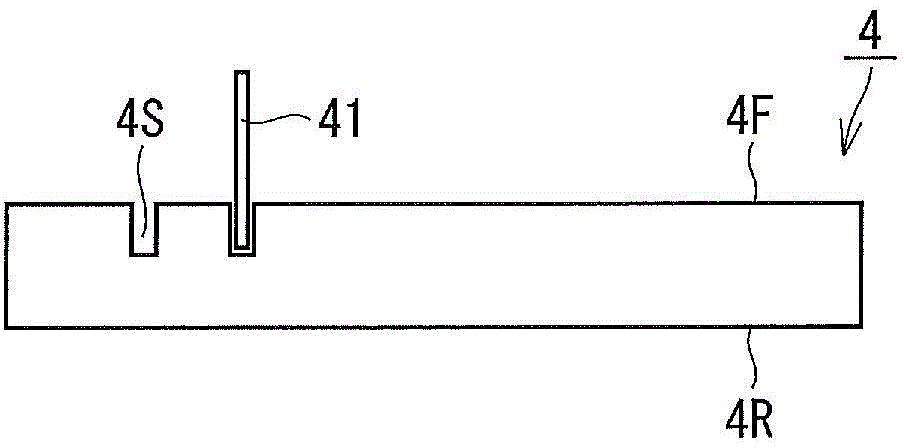Semiconductor device manufacturing method, and adhesive film used in semiconductor device manufacturing method
A manufacturing method and adhesive film technology, which are applied in semiconductor/solid-state device manufacturing, film/sheet without carrier, semiconductor devices, etc., can solve problems such as inability to properly cut off the die-bonding sheet, inability to peel off the chip-bonding sheet, etc., and achieve suppression Adhesion to the chip surface and the effect of reducing the amount of debris
- Summary
- Abstract
- Description
- Claims
- Application Information
AI Technical Summary
Problems solved by technology
Method used
Image
Examples
Embodiment 1
[0155] The following (a) to (d) were dissolved in methyl ethyl ketone to obtain an adhesive composition solution having a concentration of 23.6% by weight.
[0156] (a) 100 parts of acrylate-based polymer mainly composed of ethyl acrylate-methyl methacrylate (manufactured by Negami Industry Co., Ltd., Parachrom W-197CM)
[0157] (b) Epoxy resin (made by JER Co., Ltd., Epicoat 1004) 32 parts
[0158] (c) 34 parts of phenolic resin (Milex XLC-4L manufactured by Mitsui Chemicals Co., Ltd.)
[0159] (d) 90 parts of spherical silica (manufactured by Admatex Co., Ltd., SO-25R)
[0160] This adhesive composition solution was coated on a release-treated film (release liner) composed of a polyethylene terephthalate film having a thickness of 50 μm after a silicone release treatment, and then heated at 130° C. Let dry for 2 minutes. Thus, an adhesive film A having a thickness of 25 μm in Example 1 was obtained.
Embodiment 2
[0162] The following (a) to (d) were dissolved in methyl ethyl ketone to obtain an adhesive composition solution having a concentration of 23.6% by weight.
[0163] (a) 100 parts of acrylate-based polymer mainly composed of ethyl acrylate-methyl methacrylate (manufactured by Negami Industry Co., Ltd., Parachrom W-197CM)
[0164] (b) Epoxy resin (made by JER Co., Ltd., Epicoat 1004) 12 parts
[0165] (c) 13 parts of phenolic resin (Milex XLC-4L manufactured by Mitsui Chemicals Co., Ltd.)
[0166] (d) 188 parts of spherical silica (manufactured by Admatex Co., Ltd., SO-25R)
[0167] This adhesive composition solution was coated on a release-treated film (release liner) composed of a polyethylene terephthalate film having a thickness of 50 μm after a silicone release treatment, and then heated at 130° C. Let dry for 2 minutes. Thus, the adhesive film B of Example 2 having a thickness of 25 μm was obtained.
Embodiment 3
[0169] The following (a) to (d) were dissolved in methyl ethyl ketone to obtain an adhesive composition solution having a concentration of 23.6% by weight.
[0170] (a) 100 parts of acrylate-based polymer mainly composed of ethyl acrylate-methyl methacrylate (manufactured by Negami Industry Co., Ltd., Parachrom W-197CM)
[0171] (b) Epoxy resin (made by JER Co., Ltd., Epicoat 1004) 21 parts
[0172] (c) 22 parts of phenolic resin (Milex XLC-4L manufactured by Mitsui Chemicals Co., Ltd.)
[0173] (d) 77 parts of spherical silica (manufactured by Admatex Co., Ltd., SO-25R)
[0174] This adhesive composition solution was coated on a release-treated film (release liner) composed of a polyethylene terephthalate film having a thickness of 50 μm after a silicone release treatment, and then heated at 130° C. Let dry for 2 minutes. Thus, an adhesive film C having a thickness of 25 μm in Example 3 was obtained.
PUM
| Property | Measurement | Unit |
|---|---|---|
| particle size | aaaaa | aaaaa |
| thickness | aaaaa | aaaaa |
| length | aaaaa | aaaaa |
Abstract
Description
Claims
Application Information
 Login to View More
Login to View More - R&D
- Intellectual Property
- Life Sciences
- Materials
- Tech Scout
- Unparalleled Data Quality
- Higher Quality Content
- 60% Fewer Hallucinations
Browse by: Latest US Patents, China's latest patents, Technical Efficacy Thesaurus, Application Domain, Technology Topic, Popular Technical Reports.
© 2025 PatSnap. All rights reserved.Legal|Privacy policy|Modern Slavery Act Transparency Statement|Sitemap|About US| Contact US: help@patsnap.com



